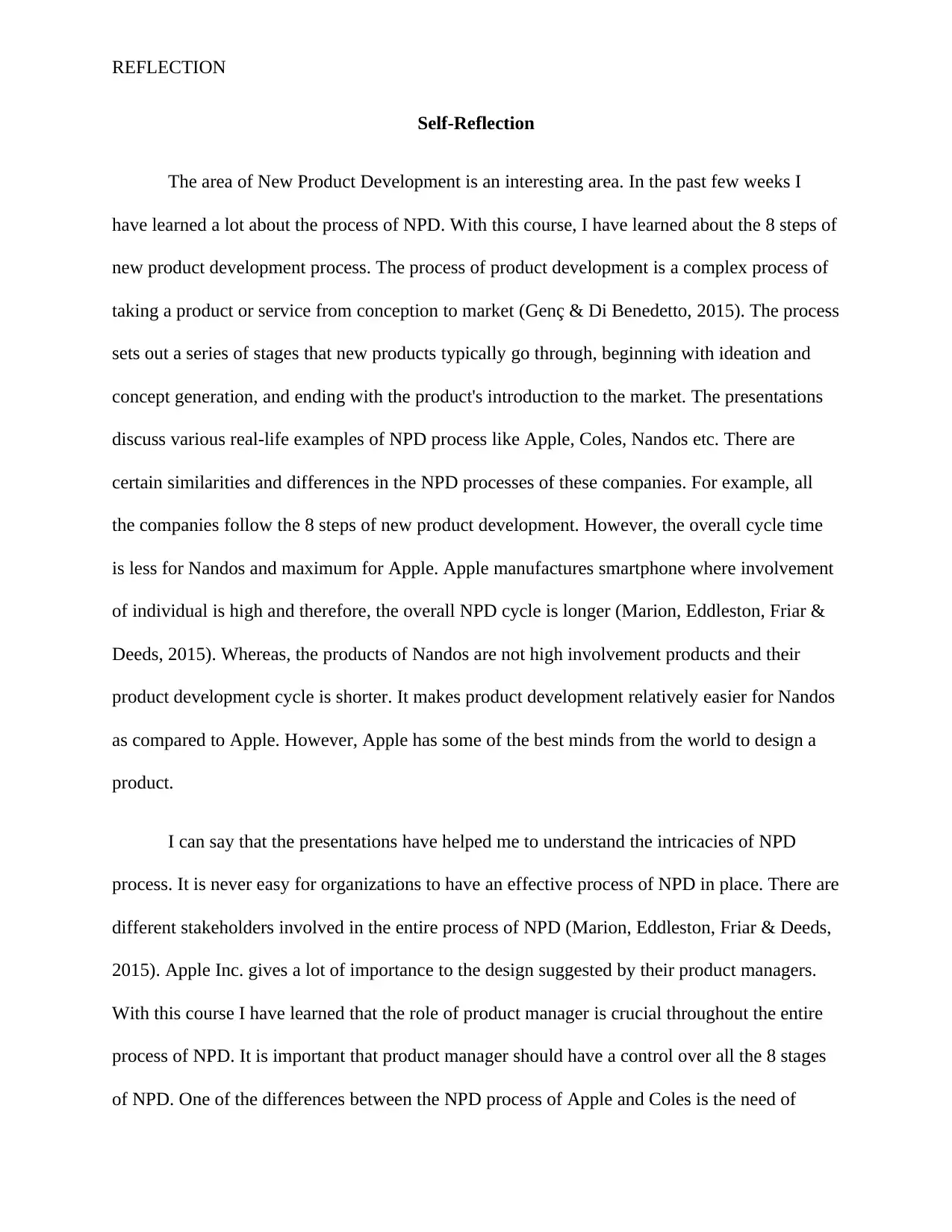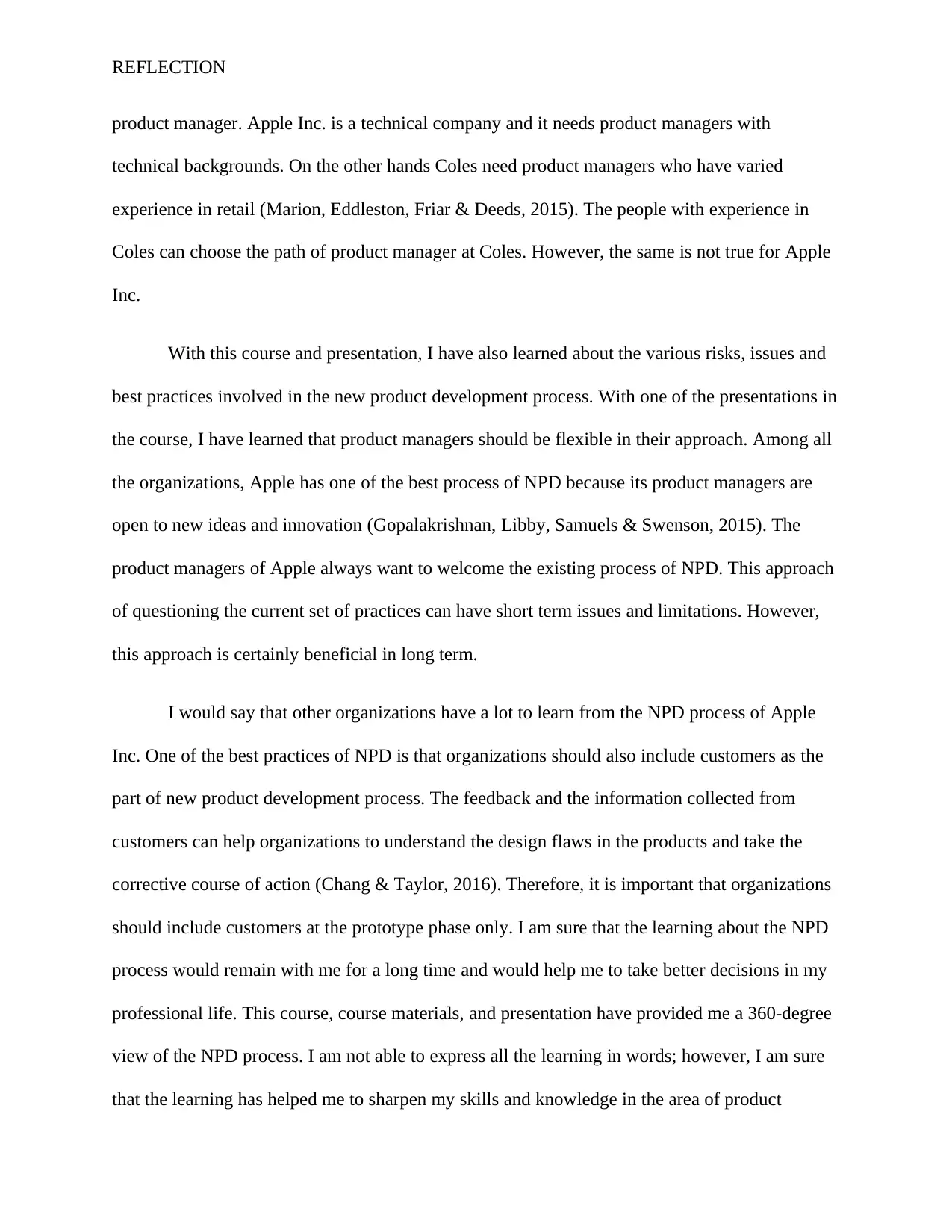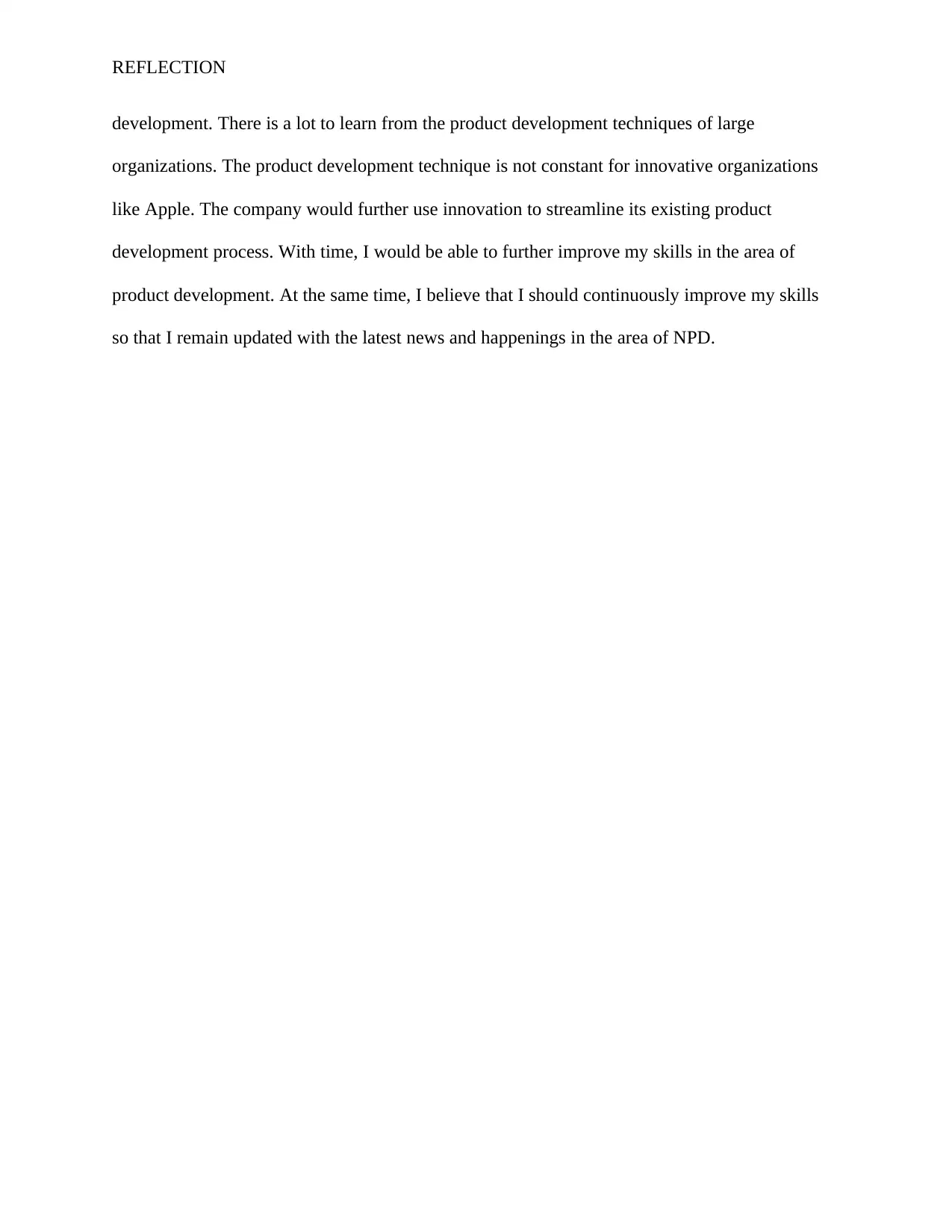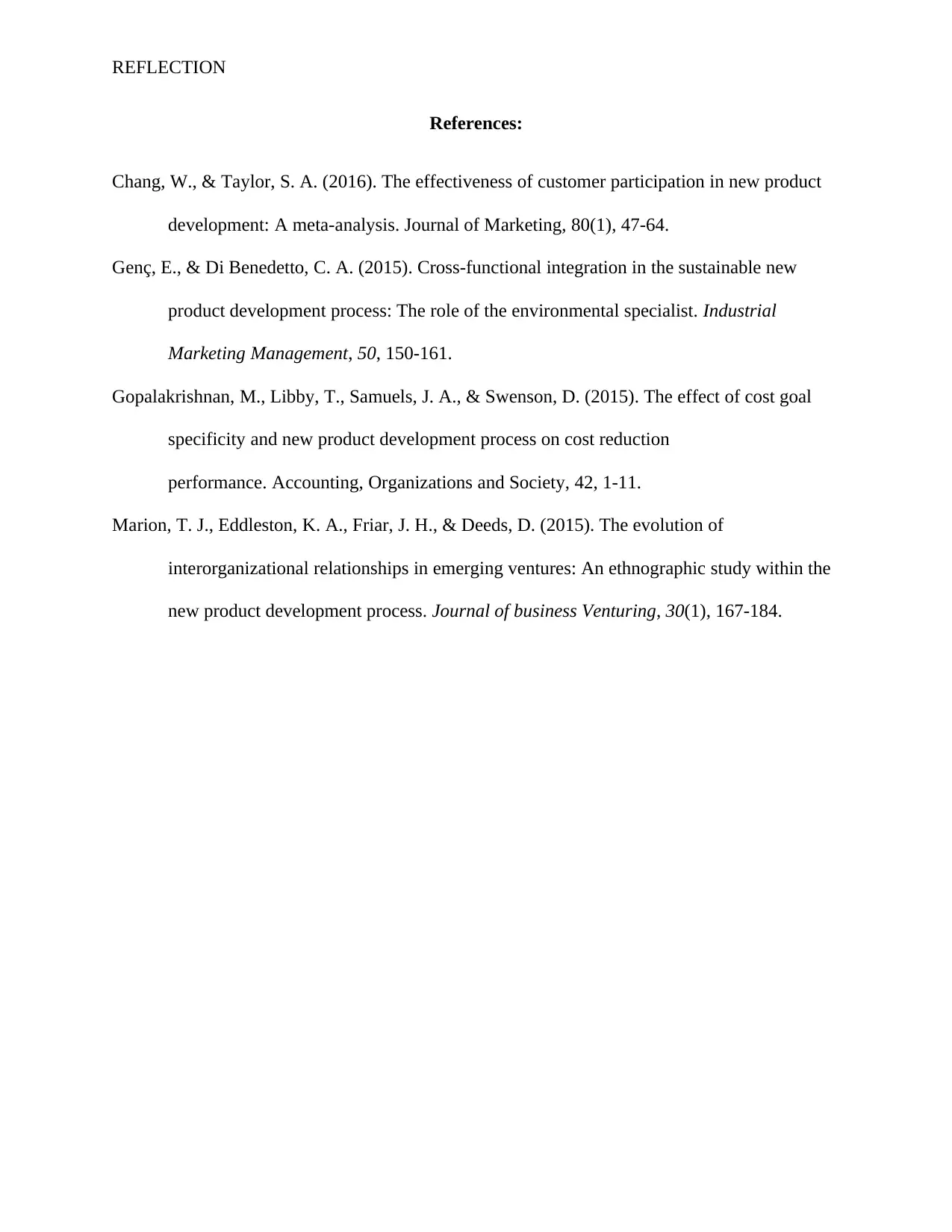Self-Reflection on Understanding the New Product Development Process
VerifiedAdded on 2023/06/11
|5
|1045
|163
Journal and Reflective Writing
AI Summary
This assignment is a student's reflection on the New Product Development (NPD) process, highlighting key learnings from a course that covered the 8 steps of NPD. The reflection compares NPD processes of companies like Apple, Coles and Nandos, noting similarities and differences in cycle times and the role of product managers. It emphasizes the importance of flexibility, innovation, and customer feedback in NPD, drawing lessons from Apple's approach. The student reflects on how this knowledge will improve their decision-making skills and stresses the need for continuous learning to stay updated in the field of product development. The course provided a 360-degree view of NPD, enhancing the student's skills and knowledge.

Running head: REFLECTION
Self-Reflection: New Product Development Process
Student’s name
Name of the Institute
Self-Reflection: New Product Development Process
Student’s name
Name of the Institute
Paraphrase This Document
Need a fresh take? Get an instant paraphrase of this document with our AI Paraphraser

REFLECTION
Self-Reflection
The area of New Product Development is an interesting area. In the past few weeks I
have learned a lot about the process of NPD. With this course, I have learned about the 8 steps of
new product development process. The process of product development is a complex process of
taking a product or service from conception to market (Genç & Di Benedetto, 2015). The process
sets out a series of stages that new products typically go through, beginning with ideation and
concept generation, and ending with the product's introduction to the market. The presentations
discuss various real-life examples of NPD process like Apple, Coles, Nandos etc. There are
certain similarities and differences in the NPD processes of these companies. For example, all
the companies follow the 8 steps of new product development. However, the overall cycle time
is less for Nandos and maximum for Apple. Apple manufactures smartphone where involvement
of individual is high and therefore, the overall NPD cycle is longer (Marion, Eddleston, Friar &
Deeds, 2015). Whereas, the products of Nandos are not high involvement products and their
product development cycle is shorter. It makes product development relatively easier for Nandos
as compared to Apple. However, Apple has some of the best minds from the world to design a
product.
I can say that the presentations have helped me to understand the intricacies of NPD
process. It is never easy for organizations to have an effective process of NPD in place. There are
different stakeholders involved in the entire process of NPD (Marion, Eddleston, Friar & Deeds,
2015). Apple Inc. gives a lot of importance to the design suggested by their product managers.
With this course I have learned that the role of product manager is crucial throughout the entire
process of NPD. It is important that product manager should have a control over all the 8 stages
of NPD. One of the differences between the NPD process of Apple and Coles is the need of
Self-Reflection
The area of New Product Development is an interesting area. In the past few weeks I
have learned a lot about the process of NPD. With this course, I have learned about the 8 steps of
new product development process. The process of product development is a complex process of
taking a product or service from conception to market (Genç & Di Benedetto, 2015). The process
sets out a series of stages that new products typically go through, beginning with ideation and
concept generation, and ending with the product's introduction to the market. The presentations
discuss various real-life examples of NPD process like Apple, Coles, Nandos etc. There are
certain similarities and differences in the NPD processes of these companies. For example, all
the companies follow the 8 steps of new product development. However, the overall cycle time
is less for Nandos and maximum for Apple. Apple manufactures smartphone where involvement
of individual is high and therefore, the overall NPD cycle is longer (Marion, Eddleston, Friar &
Deeds, 2015). Whereas, the products of Nandos are not high involvement products and their
product development cycle is shorter. It makes product development relatively easier for Nandos
as compared to Apple. However, Apple has some of the best minds from the world to design a
product.
I can say that the presentations have helped me to understand the intricacies of NPD
process. It is never easy for organizations to have an effective process of NPD in place. There are
different stakeholders involved in the entire process of NPD (Marion, Eddleston, Friar & Deeds,
2015). Apple Inc. gives a lot of importance to the design suggested by their product managers.
With this course I have learned that the role of product manager is crucial throughout the entire
process of NPD. It is important that product manager should have a control over all the 8 stages
of NPD. One of the differences between the NPD process of Apple and Coles is the need of

REFLECTION
product manager. Apple Inc. is a technical company and it needs product managers with
technical backgrounds. On the other hands Coles need product managers who have varied
experience in retail (Marion, Eddleston, Friar & Deeds, 2015). The people with experience in
Coles can choose the path of product manager at Coles. However, the same is not true for Apple
Inc.
With this course and presentation, I have also learned about the various risks, issues and
best practices involved in the new product development process. With one of the presentations in
the course, I have learned that product managers should be flexible in their approach. Among all
the organizations, Apple has one of the best process of NPD because its product managers are
open to new ideas and innovation (Gopalakrishnan, Libby, Samuels & Swenson, 2015). The
product managers of Apple always want to welcome the existing process of NPD. This approach
of questioning the current set of practices can have short term issues and limitations. However,
this approach is certainly beneficial in long term.
I would say that other organizations have a lot to learn from the NPD process of Apple
Inc. One of the best practices of NPD is that organizations should also include customers as the
part of new product development process. The feedback and the information collected from
customers can help organizations to understand the design flaws in the products and take the
corrective course of action (Chang & Taylor, 2016). Therefore, it is important that organizations
should include customers at the prototype phase only. I am sure that the learning about the NPD
process would remain with me for a long time and would help me to take better decisions in my
professional life. This course, course materials, and presentation have provided me a 360-degree
view of the NPD process. I am not able to express all the learning in words; however, I am sure
that the learning has helped me to sharpen my skills and knowledge in the area of product
product manager. Apple Inc. is a technical company and it needs product managers with
technical backgrounds. On the other hands Coles need product managers who have varied
experience in retail (Marion, Eddleston, Friar & Deeds, 2015). The people with experience in
Coles can choose the path of product manager at Coles. However, the same is not true for Apple
Inc.
With this course and presentation, I have also learned about the various risks, issues and
best practices involved in the new product development process. With one of the presentations in
the course, I have learned that product managers should be flexible in their approach. Among all
the organizations, Apple has one of the best process of NPD because its product managers are
open to new ideas and innovation (Gopalakrishnan, Libby, Samuels & Swenson, 2015). The
product managers of Apple always want to welcome the existing process of NPD. This approach
of questioning the current set of practices can have short term issues and limitations. However,
this approach is certainly beneficial in long term.
I would say that other organizations have a lot to learn from the NPD process of Apple
Inc. One of the best practices of NPD is that organizations should also include customers as the
part of new product development process. The feedback and the information collected from
customers can help organizations to understand the design flaws in the products and take the
corrective course of action (Chang & Taylor, 2016). Therefore, it is important that organizations
should include customers at the prototype phase only. I am sure that the learning about the NPD
process would remain with me for a long time and would help me to take better decisions in my
professional life. This course, course materials, and presentation have provided me a 360-degree
view of the NPD process. I am not able to express all the learning in words; however, I am sure
that the learning has helped me to sharpen my skills and knowledge in the area of product
⊘ This is a preview!⊘
Do you want full access?
Subscribe today to unlock all pages.

Trusted by 1+ million students worldwide

REFLECTION
development. There is a lot to learn from the product development techniques of large
organizations. The product development technique is not constant for innovative organizations
like Apple. The company would further use innovation to streamline its existing product
development process. With time, I would be able to further improve my skills in the area of
product development. At the same time, I believe that I should continuously improve my skills
so that I remain updated with the latest news and happenings in the area of NPD.
development. There is a lot to learn from the product development techniques of large
organizations. The product development technique is not constant for innovative organizations
like Apple. The company would further use innovation to streamline its existing product
development process. With time, I would be able to further improve my skills in the area of
product development. At the same time, I believe that I should continuously improve my skills
so that I remain updated with the latest news and happenings in the area of NPD.
Paraphrase This Document
Need a fresh take? Get an instant paraphrase of this document with our AI Paraphraser

REFLECTION
References:
Chang, W., & Taylor, S. A. (2016). The effectiveness of customer participation in new product
development: A meta-analysis. Journal of Marketing, 80(1), 47-64.
Genç, E., & Di Benedetto, C. A. (2015). Cross-functional integration in the sustainable new
product development process: The role of the environmental specialist. Industrial
Marketing Management, 50, 150-161.
Gopalakrishnan, M., Libby, T., Samuels, J. A., & Swenson, D. (2015). The effect of cost goal
specificity and new product development process on cost reduction
performance. Accounting, Organizations and Society, 42, 1-11.
Marion, T. J., Eddleston, K. A., Friar, J. H., & Deeds, D. (2015). The evolution of
interorganizational relationships in emerging ventures: An ethnographic study within the
new product development process. Journal of business Venturing, 30(1), 167-184.
References:
Chang, W., & Taylor, S. A. (2016). The effectiveness of customer participation in new product
development: A meta-analysis. Journal of Marketing, 80(1), 47-64.
Genç, E., & Di Benedetto, C. A. (2015). Cross-functional integration in the sustainable new
product development process: The role of the environmental specialist. Industrial
Marketing Management, 50, 150-161.
Gopalakrishnan, M., Libby, T., Samuels, J. A., & Swenson, D. (2015). The effect of cost goal
specificity and new product development process on cost reduction
performance. Accounting, Organizations and Society, 42, 1-11.
Marion, T. J., Eddleston, K. A., Friar, J. H., & Deeds, D. (2015). The evolution of
interorganizational relationships in emerging ventures: An ethnographic study within the
new product development process. Journal of business Venturing, 30(1), 167-184.
1 out of 5
Related Documents
Your All-in-One AI-Powered Toolkit for Academic Success.
+13062052269
info@desklib.com
Available 24*7 on WhatsApp / Email
![[object Object]](/_next/static/media/star-bottom.7253800d.svg)
Unlock your academic potential
Copyright © 2020–2025 A2Z Services. All Rights Reserved. Developed and managed by ZUCOL.





